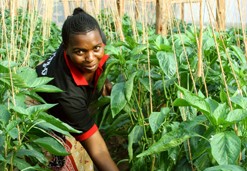
Today, close to 925 million people worldwide suffer from chronic hunger and poverty. Yearly, at least 3.5 million children die from causes related to undernutrition, whose root cause is poverty. Undernutrition can shorten lives, affect physical and cognitive development, cost countries as much as 3 percent of their annual gross domestic product, and reduce lifetime potential individual earnings by 10 percent.
In July 2009, global leaders at the G8 Summit in L’Aquila, Italy, laid the foundation for a concerted effort to create sustainable global food security. When President Barack Obama committed more than $3.5 billion for agriculture development and food security over three years, other donors leveraged this pledge with another $18.5 billion in support of a shared approach.
This approach, endorsed by 193 countries at the November 2009 World Summit on Food Security in Rome, supports the United Nations Millennium Development Goal 1 to halve, by year 2015, the proportion of people living in extreme poverty. Donors pledged to invest in comprehensive, country-owned, strategically coordinated plans that leverage and align multilateral institution efforts that deliver on sustained and accountable commitments.
To meet U.S. obligations, President Obama launched the Feed the Future (FTF) initiative, a whole-of-government approach that involves a variety of U.S. agencies, including the U.S. Agency for International Development (USAID), Department of State, Department of Agriculture, Millennium Challenge Corporation, Peace Corps, and Department of the Treasury. In May 2010, USAID Administrator, Dr. Rajiv Shah, announced FTF’s pledge to “work in partnership, not patronage” with 16 potential focus countries from Africa, plus Bangladesh, Guatemala, Nepal, and Nicaragua. Selection criteria included poverty dynamics and prevalence, undernutrition, country commitment, and prospects for agriculture-led growth.
And how important is water in all of this?
“Water is one of the four pillars of agriculture, along with soil, seed, and labor,” says USAID staff member and FTF Senior Advisor, Dr. Lawrence Rubey. “We are seeing greater emphasis on water as a resource because of climate change, which is expected to lead to more intense and variable rainfall and drought. Smart water management is vital.”
The Feed the Future Guide, May 2010 affirms, “Sound management of natural assets – including land, water, forests, and fisheries – provides benefits to food production, environmental health, and nutrition.” Also, according to the guide, “Properly managed watersheds, rangelands, forests, and fisheries enhance ecosystem functions that boost agricultural productivity, increase access to clean water, replenish aquifers, mitigate damage from storms and floods, and reduce negative environmental impacts from agriculture.”
In one potential FTF focus country, Rwanda, almost 80% of the nation’s labor force makes its living from agriculture. About 52% of Rwanda’s children are chronically malnourished. Most of the arable land is on hillsides. Soil erosion, lack of access to markets and finance, and inefficiencies of scale contribute to food insecurity. Rwanda’s agriculture is almost entirely rain-fed, making climate change, drought, and landslides major concerns.
The Rwanda/USAID Mission’s FTF implementation plan details a land husbandry, water harvesting, and hillside irrigation (LWH) initiative. The Rwandan government designed LWH several years ago when it recognized the country’s massive soil erosion problem and other vulnerabilities to climate change. LWH is now scheduled to be funded not only by Rwanda’s Ministry of Agriculture and Animal Resources, but by partners that include the governments of Canada and Japan, the World Bank, the World Bank-administered Global Agriculture and Food Security Program, and FTF.
“The opportunity to support a program that is government-led and is built in consultation with multiple stakeholders represents a new partner relationship. “The U.S. government is working to make this happen,” said Brian Frantz, USAID/Rwanda’s general development officer. “This collaboration and leveraging with others gives us a chance to have a real impact on shared objectives.”
Modern agriculture practices are not widespread in Rwanda. Most of the Rwanda project area will benefit from land husbandry, which uses better soil management and rainwater catchment techniques. Fewer crops will be lost because terracing will make Rwanda more resilient to the negative effects of climate change. Water harvesting will allow for year-round irrigation. By 2012, all interventions are expected to increase traditional annual crops produced on rain-fed lands by 20%, perennial crops by 40%, and irrigated crops by 50%.
“A goal set by the Rwandan government has been to increase the share of arable land under sustainable management practices. This program already is doing this,” Frantz continued.
In an August 4, 2010 speech, Ambassador William Garvelink, FTF’s Deputy Coordinator for Development, stated: “Feed the Future recognizes that food security is not just about food, but it is closely linked to economic security, environmental security, and human security.”
Recognizing the critical role of water in food security, the Ambassador elaborated, “As we review emerging strategies on how best to implement Feed the Future on the ground, we see that water – from farming to important links between clean water and child nutrition – is a critical component throughout.”
Successfully integrating all components necessary to improve the food security of the global population is clearly the challenge and the hope of this vital initiative. M. Davis
For more information, visit:
http://www.feedthefuture.gov/
http://www.fao.org/fileadmin/templates/wsfs/Summit/Docs/Final_Declaration/WSFS09_Declaration.pdf
http://www.un.org/millenniumgoals/







Comment
Make a general inquiry or suggest an improvement.